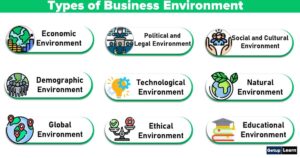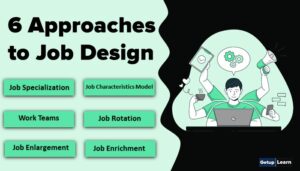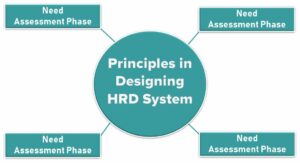Some commentators use a similar term for workplace learning to improve performance: “training and development”.
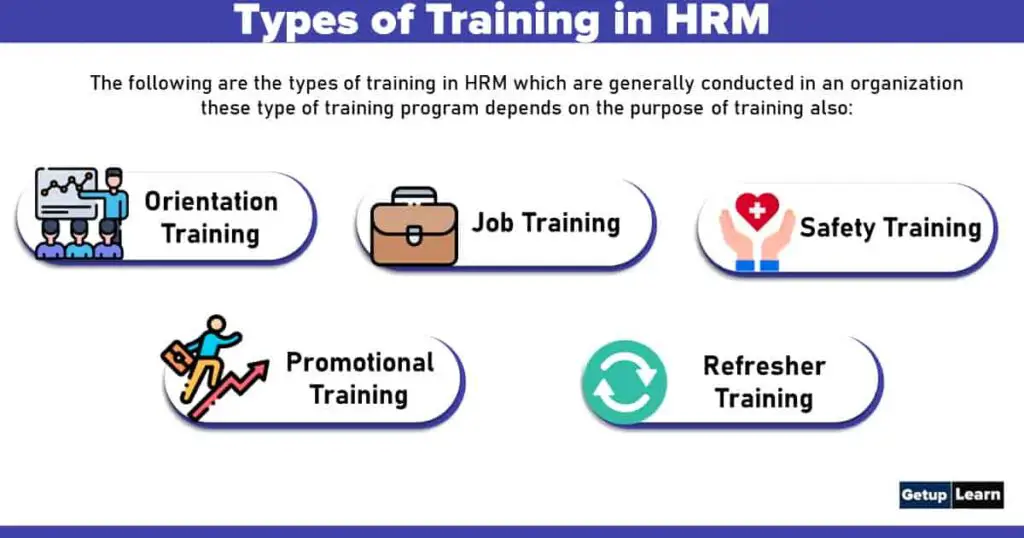
One can generally categorize such training as on-the-job or off-the-job:
- On-the-job training takes place in a normal working situation, using the actual tools, equipment, documents or materials that trainees will use when fully trained. On-the-job training has a general reputation as the most effective for vocational work.
- Off-the-job training takes place away from normal work situations — implying that the employee does not count as a directly productive worker while such training takes place. Off-the-job training has the advantage that it allows people to get away from work and concentrate more thoroughly on the training itself. This type of training has proven more effective in inculcating concepts and ideas.
The most frequently used method in smaller organizations is on the job training. This method of training uses more knowledgeable, experienced and skilled employees, such as managers, and supervisors to give training to less knowledgeable, skilled, and experienced employees. OJT can be delivered in classrooms as well. This type of training often takes place at the workplace in an informal manner.
Corporate Training Services have become indispensable for organizations striving to stay ahead in today’s competitive business environment. This specialized form of training is designed to enhance the skills and knowledge of employees, aligning them with the company’s goals and industry trends.
With Corporate Training Services, businesses can address specific needs such as leadership development, technological advancements, or compliance requirements. These services often encompass a range of formats, including workshops, seminars, online courses, and personalized coaching sessions. Investing in Corporate Training Services not only equips employees with the latest tools and information but also fosters a culture of continuous learning within the organization.
Table of Contents
9 Types of Training in HRM
The following are the types of training programs which are generally conducted in an organisation these type of training program depends on the purpose of training also:
- Orientation Training
- Job Training
- Promotional Training
- Refresher Training
- Apprenticeship Training
- T- Group Training
- Fish Bowl Technique
- Online Training
- Internship Training
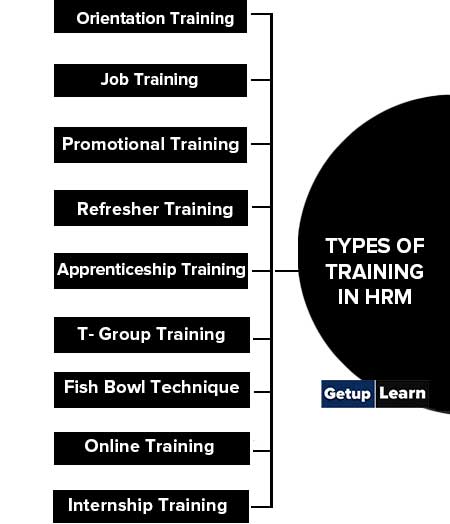
Orientation Training
Induction training or orientation training is generally undertaken when a new employee joins the organisation. It is a way in which the new employee is introduced to his job and his co-workers. During the in- duction training, the employee is informed about the rules, working conditions, privileges and activities of the company.
The induction training not only helps the new employee to adjust to his job and workgroup but also promotes good morale in the organisation.
Job Training
Job training is undertaken to increase the knowledge of the workers about the job with which they are connected for improving their efficiency and skills. Through it, the workers are able to learn the correct methods of handling machines and equipment avoiding accidents, minimizing waste etc.
For this, an employee is placed in a new job and is told how it may be performed. It is primarily concerned with developing in an employee the skills and habits consistent with the existing practices of an organisation and with orienting him to his immediate problems.
The employees learn the job by personal observation and practice as well as occasionally handling it. It is learning by doing, and it is most useful for jobs that are either difficult to explain or can be learned quickly by watching and doing.
Promotional Training
Many concerns follow a policy of filling some of the vacancies at higher levels by promoting existing employees. This policy increases the morale of workers. When the existing employees are promoted to superior positions in the organisation, they are required to shoulder new responsibilities. For this, training appropriate training is given to them.
Refresher Training
With the passage of time, employees may forget some of the methods, which were taught to them, or they may have become outdated because of technological development and improved techniques of management and production. Hence, refresher training is arranged for existing employees in order to provide them with an opportunity to revive and improve their knowledge.
Refresher training is essential because the employees require training to bring them up-to-date with the knowledge and skills and to relearn what they have forgotten. Rapid technological changes make even the most qualified workers obsolete in course of time and refresher training becomes necessary when the new jobs are created are to be filled in by the existing employees.
Apprenticeship Training
The apprenticeship training system is widely in vogue today in many industries. It is a good source of providing the required personnel for the industry. Under this method, both knowledge and skills in doing a job or a series of related jobs are involved.
The apprenticeship programs combine on-the-job training and experience in classroom instructions in particular subjects. Apprenticeship training is desirable in industries, which require a constant flow of new employees who are expected to become all-round craftsmen.
T- Group Training
A T-Group or training group is an experience-based learning technique wherein the participants work in a small group of 8-14 people over an extended period of time. The learning from this training comes from an analysis of the interactions that the participants have with each other as well as their own experiences, feelings, reactions, perceptions and behaviour.
The following are some of the assumptions of this method:
- Responsibility of Learning
- Role of the staff person
- Experience and conceptualization
- Establishment of authentic relationships and learning.
Fish Bowl Technique
When large to medium discussions have to be undertaken, the Fishbowl technique of discussion can be used. The participants are separated into an inner and outer circle. The ones in the inner circle would be undertaking the discussion while the ones in the outer circle listen to the discussion and take notes.
Due to this multiple viewpoints can be collected from the inner circle and the insights from the outer group can provide an effective contribution to the discussion which makes this method effective when large numbers of participants are involved.
Online Training
Online training is also known as Computer Based Training (CBT), distance learning, e-learning or online training. It takes place completely on the internet and involves multimedia elements such as graphics, audio, video and web links which are accessed through the internet browser. Employers in present times are increasingly opting to train their employees using the online method as the training provided can be in an interactive manner.
Internship Training
Internship training is usually meant for such vocations where advanced theoretical knowledge is to be backed up by practical experience on the job. Under this method, the professional institutes enter into arrangements with a big business enterprise for providing practical knowledge to its students.
For Example Engineering, students are sent to industrial enterprises and medical students are sent to hospitals for practical knowledge.
Methods of Training in Hrm
In order to train employees, the organisation has a broad range of methods which are available. On the basis of the goals and needs, a proper method should be chosen. The methods of training in hrm can be broadly divided into two categories:
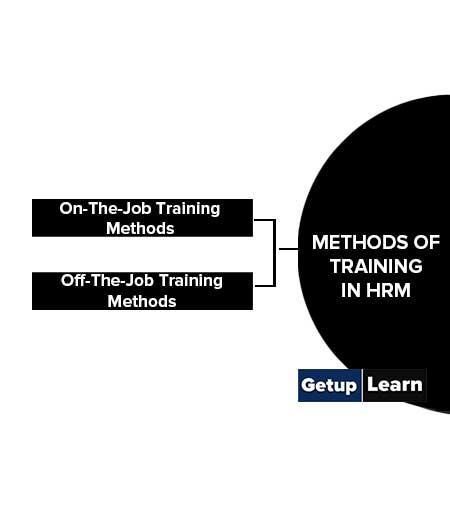
On-The-Job Training Methods
In this method, the employees learn how to do the job by actually doing it. The basic idea behind this method of training is to transfer the skills and knowledge from experienced employees to new employees when they are working in order to sustain the productivity of both the employees.
The various types of on-the-job training methods are as under:

Apprenticeship Training
It is adopted by many organisations wherein the new employee is appointed under a supervisor who is a highly-skilled person. The super-visor acts as an instructor and imparts knowledge to the trainee. Such training programs can last for a few years or several years depending upon the nature and complexity of the job.
The main motivation factor for the trainees here is the awareness that they are acquiring the exact knowledge needed to perform their jobs.
Job Rotation
Which helps them to undertake different jobs in a comfortable manner. It also enables Off-The-Job Training Methods organisations to effect transfers in the organisation and achieve desired productivity which helps in attaining organizational goals. This type of training is generally practised for entry-level jobs to impart skills to the new employees and helps them to perform their various jobs.
Internship
An internship is concerned with gaining supervised practical experience. It combines the theory which is learned in the classroom with actual business practices. The trainee is appointed in a temporary job and the organisation has no obligation to hire them. Further, the trainee is also under no obligation to accept a job offer.
An internship is beneficial to both parties as to the interns or the trainees get hands-on practical knowledge. The organisation also gets a trained employee if the intern accepts a job offer. One of the best features of this method is that the organisation gets to test the employee before the job offer can be given to them.
Job Instruction Training
Under this method, a step by step process is followed. For this a brief write up for each step is prepared and then they are compiled sequentially. Each step would have a self-explanatory note which would have instructions as to how a said job has to be done and it would highlight the importance of each step. This method will help the trainee to learn a job with minimum guidance of the trainee.
Off-The-Job Training Methods
Under their methods, the training is imparted at a place away from their usual workplace. It could be a classroom or a training centre. The main aim is to minimise the distractions to the trainees. These methods are ideal to teach theoretical aspects of the jobs.
The following types of training methods are included in off-the-job training methods:
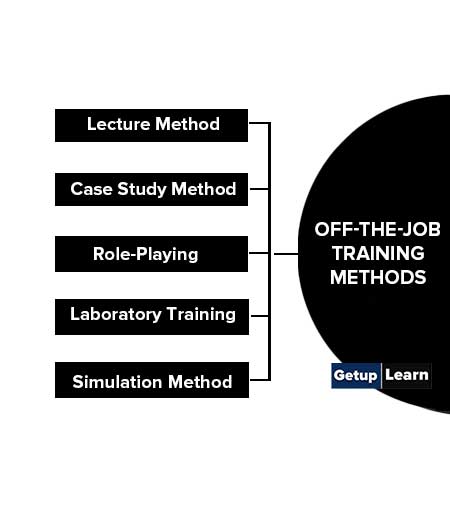
Lecture Method
This method is popularly known as the chalk and talk method. It is a traditional method of delivering verbal information in a classroom environment. This method is used when a large amount of information is to be provided in a limited span of time. This method is very useful in cases where the trainer has the ability to make the whole process of learning exciting and has the competence to capture the imagination of the class.
The major benefits of this method are that it is a simple and quick method of sharing information and the cost per trainee is also very less. But on the other hand, one of the major limitations of this method is that it is a predominantly one-way mode of communication with very less scope for interaction.
Case Study Method
In this method, trainees are provided with necessary information about a situation and they have to come up with a decision based on their understanding of a given case. Each such situation given would have a specific set of real or imaginary incidents.
Under this method, the trainees are expected to evaluate the cases carefully, identify the cause of the problem and develop solutions to address the problems in an effective manner. This method is beneficial as it helps the trainee to develop and improve their analytical and judgmental skills and prepares them to face real-life situations in the desired manner.
Role-Playing
Role-playing refers to acting out a particular role. It is a form of learning by doing. In this method, a trainee assumes the role of a particular personality in a given situation and responds in a manner which is expected in a real-life situation. It might be possible that the role assigned to the trainer is that of a superior or that of a subordinate.
This method is used to impart the skills necessary for conducting interviews, handling grievances, performance evaluations or undertaking disciplinary actions. It also helps in enhancing the interpersonal relations between the trainees and develops leadership qualities. It also helps the employees to understand various perspectives of a given problem and develops the empathetic qualities the employees.
Laboratory Training
It is also referred to as sensitivity training. It generally involves a small group of trainees who are familiar with each other. A supervisor who is an experienced trainer is appointed and plays a role of an observer. Trainers are allowed to meet each other personally for sharing their feelings, opinions, attitudes, perceptions and values.
This method is very useful for increasing understanding among the members. It also helps in resolving the conflicts among the trainees as due to interactions among themselves, the employees are able to understand each other in a better manner. But it may be possible that whatever has been achieved in the training phase might not continue in the actual workplace.
Simulation Method
It is used when on-the-job training methods cannot be adopted for providing training. It might be possible that the situations for which training has to be provided are impossible to create or are risky to be undertaken. It involves giving training to trainers on equipment which creates real life-like situations and provides trainees with an environment where realistic decision making has to be undertaken.
The trainers review the performance, prepare the reports and make them available to the trainees. This method ensures that the trainees are free from any dangers of on-the-job training and the cost of training would also be reduced. Further, repeat performances can also be used which would improve the decision making ability of the trainees.
Conditions of Effective Training Program
The following are the factors for conditions of an effective training program:
- Support of the Top Management
- Mindset of Trainees
- Training Should Be a Continuous Process
- Form and Timing of Training
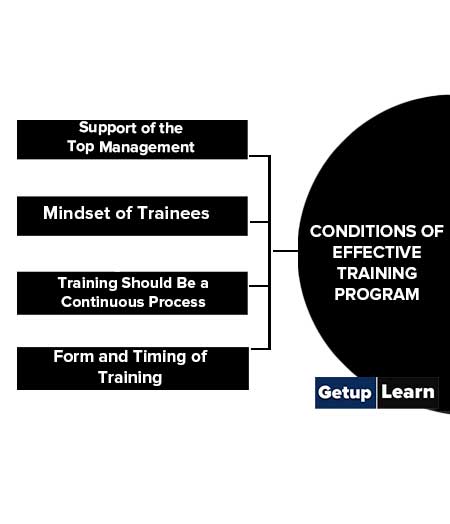
Support of the Top Management
In order to ensure that the training programs are successful, the commitment of top management is very essential. The top management should treat training as an important part of the corporate culture. It should be committed to providing all necessary resources and time for training programs.
Mindset of Trainees
It is very important that the organisation develops a positive mindset among the trainees who participate in the programs. An open and receptive mindset helps them to learn new ideas, skills and knowledge in a quick and efficient manner.
Training Should Be a Continuous Process
The organisation should adopt a comprehensive, continuous and systematic approach to fulfilling the training needs of the employees. The training programs should support the strategic goals of the organisation on a sustained basis. An ad-hoc approach to training may not be effective as there might be a gap in the implementation of the training programs.
Form and Timing of Training
An ideal time to learn should be the time when training would be helpful to the employees. With increased competition and technological advancements, organisations are forced to carry out training programs on a routine basis. For this, the training requirements have to be identified by constantly exploring the market conditions and deciding the type of training which have to be provided.
Challenges of Training in Hrm
These are some points of challenges of training in hrm:
- One of the major problems which the organisation faces is the absence of corporate commitment to the organisation toward a training program. Mostly, training programs are undertaken only for managerial personnel and the training requirements of workers are hardly considered by the organisation.
- It might also be possible that after taking training and upgrading their skills, the employees might leave the organisation. So many a times, especially small business concerns avoid training programs.
- Training programs generally involve high costs and so are avoided by the organisation.
- It might also be possible that the employees who are available might be lacking even the basic skills of the job. So training from the first stage has to be arranged by the organisation to make them employable.
What are the types of training in HRM?
Training is the act of increasing the knowledge and skills of an employee for doing a particular job. Types of Training in HRM: 1. Orientation Training, 2. Job Training, 3. Safety Training, 4. Promotional Training, Refresher Training.





